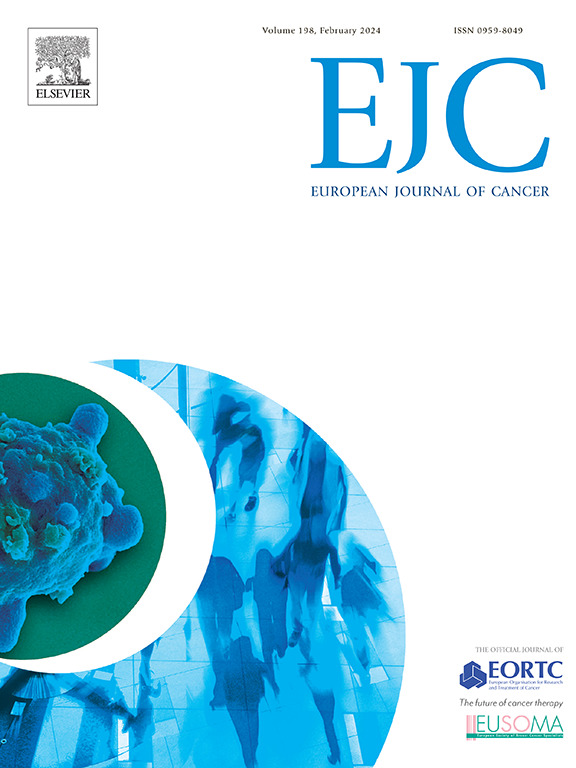The european organisation for research and treatment of cancer head and neck cancer module (EORTC QLQ-HN43): Estimates for minimal important difference and minimal important change
IF 7.6
1区 医学
Q1 ONCOLOGY
引用次数: 0
Abstract
Introduction
Minimal important change estimates (MIC) are useful for interpreting results of clinical research with quality of life (QoL) as an endpoint. For the European Organisation for Research and Treatment of Cancer head and neck cancer module, the EORTC QLQ-HN43, no such thresholds are established.
Methods
Head and neck cancer patients under active treatment (n = 503) from 15 countries completed the EORTC QLQ-HN43 three times (t1: before treatment, t2: three months after t1, t3: six months after t1). A subgroup completed a Subjective Significance Questionnaire (SSQ), indicating experienced change from the previous time point in four QoL domains. QoL was assumed to deteriorate after t1 and improve again until t3. The MIC was established using the average of mean differences in SSQ groups (MICmean) and estimates based on logistic regressions (MICpredict). Additionally, minimal detectable changes (MDC) were computed using 0.5 standard deviation and standard error of the mean.
Results
For swallowing, speech, dry mouth, and global QoL, the MIC for deterioration were 13, 14, 26, and 10 respectively. The MIC for improvement were 8 (swallowing), 6 (dry mouth), and 5 (global QoL); no MIC for speech improvement can be presented because of insufficient correlation between change score and anchor. The MDC estimates for deterioration were 15, 14, 15, and 11. For improvement, the MDC estimates were 13, 14, 14, and 11.
Conclusions
Our results underline that no single MIC or MDC can be applied to all EORTC QLQ-HN43 scales, and that the MIC for deterioration seems larger than those for improvement.
欧洲癌症研究和治疗组织头颈癌模块(EORTC QLQ-HN43):最小重要差异和最小重要变化的估计值
引言最小重要变化估计值(MIC)有助于解释以生活质量(QoL)为终点的临床研究结果。来自 15 个国家的正在接受积极治疗的头颈部癌症患者(n = 503)三次完成了 EORTC QLQ-HN43 模块(t1:治疗前,t2:t1 后三个月,t3:t1 后六个月)。一个亚组完成了主观意义问卷(SSQ),显示了与前一个时间点相比在四个 QoL 领域中经历的变化。假定 QoL 在 t1 之后恶化,并在 t3 之前再次改善。根据 SSQ 各组平均差异的平均值(MICmean)和基于逻辑回归的估计值(MICpredict)确定 MIC。结果 在吞咽、言语、口干和整体 QoL 方面,恶化的 MIC 分别为 13、14、26 和 10。言语能力改善的 MIC 值分别为 8(吞咽)、6(口干)和 5(整体 QoL);由于变化分数与锚点之间的相关性不足,因此无法提供言语能力改善的 MIC 值。恶化的 MDC 估计值分别为 15、14、15 和 11。结论我们的研究结果表明,没有任何一种 MIC 或 MDC 可适用于所有 EORTC QLQ-HN43 量表,恶化的 MIC 似乎大于改善的 MIC。
本文章由计算机程序翻译,如有差异,请以英文原文为准。
求助全文
约1分钟内获得全文
求助全文
来源期刊

European Journal of Cancer
医学-肿瘤学
CiteScore
11.50
自引率
4.80%
发文量
953
审稿时长
23 days
期刊介绍:
The European Journal of Cancer (EJC) serves as a comprehensive platform integrating preclinical, digital, translational, and clinical research across the spectrum of cancer. From epidemiology, carcinogenesis, and biology to groundbreaking innovations in cancer treatment and patient care, the journal covers a wide array of topics. We publish original research, reviews, previews, editorial comments, and correspondence, fostering dialogue and advancement in the fight against cancer. Join us in our mission to drive progress and improve outcomes in cancer research and patient care.
 求助内容:
求助内容: 应助结果提醒方式:
应助结果提醒方式:


